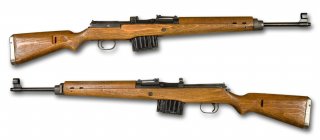No, the Gewehr 43 Was Not a German M1 Garand
The Gewehr 43 or G43, a semi-automatic rifle, has erroneously been described as the German’s M1 Garand. However, while both were fine weapons the only thing that the two had in common was that both were semi-automatic.
When World War II began in September 1939, the armies of Europe were still largely carrying bolt action rifles that were little improved over what had been used a generation earlier during the First World War. New focus had been on machine guns such as Germany’s general purpose MG34, the Soviet’s DP-28 and Great Britain’s Bren Gun; and to a lesser degree submachine guns, notably Germany's MP38 and the Soviet’s PPD—little consideration had been placed on a “self-loading rifle” or semi-automatic.
By contrast, the United States military sought to develop such a weapon, and while a number of rifles were considered and tested, in the end, it came down to the M1 Garand. It was best described by General George S. Patton as, “The greatest battle implement ever devised.”
As the war progressed Germany developed new and improved firearms, including its MG42 machine gun and the world’s first “assault rifle,” the StG44. The German military even developed a special select-fire rifle for its elite paratroopers, the FG42.
Then there was the Gewehr 43 or G43, a semi-automatic rifle that has erroneously been described as the German’s M1 Garand. However, while both were fine weapons the only thing that the two had in common was that both were semi-automatic.
Development of the G43
During the 1930s the German military had rearmed and this led to the adoption of the aforementioned MG-34 general-purpose machine gun, and later the MP-38/40, the iconic and erroneously named “Schmeisser” submachine gun, but even in 1941 with the invasion of the Soviet Union the German military was still largely equipped with the Kar-98K bolt action rifle.
In 1941 the German military sought to develop a semi-automatic rifle, and two different firms—Mauser and Walther—were charged with its development. Nearly thirteen thousand Mauser patterns were produced but neither it nor the Walther design provided reliable enough or met the demands of the military. Instead, the designers looked to captured stocks of the Soviet SVT-40 and noted the simple gas mechanism.
While the German semi-automatic been dubbed the “German M1Garand” by firearms enthusiasts, it would be fairer to suggest it was the German take on the SVT-40’s action while taking elements from the Mauser developed G41(W).
The G43 was accepted and entered service originally as the Gewehr 43 (G43) in October 1943. However, the naming was confusing due to the fact that the main bolt action rifle was officially a “Karabiner” (carbine) while Gewehr meant “long rifle.” For this reason, in 1944 the weapon was re-designated the Karabiner (K43). The two are identical in every way apart from the letters stamped on the side. Even today among collectors the rifle is generally known as the G43, while some published sources use the K43 nomenclature.
German military doctrine was to provide each infantry company with 19 G43s, including ten that would be fitted with scopes for marksmen. However, as the war effort turned against the Germans neither goal was ever achieved. Of the 402,713 G43s that were produced a total of 53,435 were outfitted as sniper rifles and those were fitted with Zielfernrohr 43 (ZF4) telescopic sights with 4x magnification.
Given the small numbers the G43 had little effect on the outcome of the war, and the rifle didn’t have much of a lasting legacy, but this could be due in no small part to the fact that Germany lost the war and arms development essentially ended for a decade. Likewise, the StG44 proved to be the more influential weapon, while elements from the FG42 were utilized in such small arms as the American M60 machine gun.
Yet, while it wasn’t really the German's version of the M1 Garand, the G43 was still a fine weapon that greatly improved on the bolt action Kar-98K.
Peter Suciu is a Michigan-based writer who has contributed to more than four dozen magazines, newspapers and websites. He is the author of several books on military headgear including A Gallery of Military Headdress, which is available on Amazon.com.
Image: Wikimedia Commons / Armémuseum

